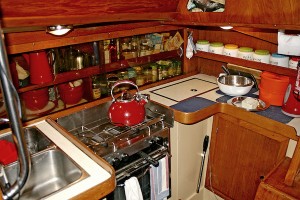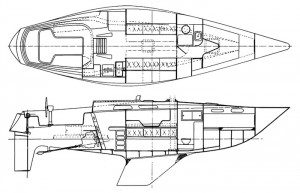Of all the design offices to rise to prominence in the 20th century, Sparkman & Stephens must rank near the top. From cruising yachts to America’s Cup 12 metres (with an unsurpassed record of six winners), the iconic S & S name ruled supreme.
Brothers Olin and Rod made their mark in 1931 when their beautiful 52ft yawl Dorade carried off the Transatlantic Race closely followed by the Fastnet. And thus began a six-decade domination of inshore and offshore racing on both sides of the Atlantic. When the mould-breaking Dorade hit the scene, Olin was just 23. While he drew the lines with his unique blend of artistry and science, his brother Rod applied his seaman’s eye to gear, layout, construction and fit-out.
Thereafter, commissions cascaded in and thousands of cruising and racing S&S designs hit the slips, going on to enhance the sailing scene with their grace and sailing prowess.
Design No. 2166 started life on the drawing board in 1974/5 in the US as the Three Quarter Ton cruiser-racer Northstar 1500, subsequently renamed the Northstar 50 then the Hughes 35.
British builder South Hants Engineering introduced another take on Design 2166, calling it the She 36. The S&S website shows its dimensions as LOA 35ft 6in, LWL 26ft, beam 10ft 5in, draught 6ft and isplacement 11,500 lbs. The She 36 brochure says it displaces around 5 ½ tons.

A sleek, low coachroof, balanced overhangs and typical S&S tumblehome – from any angle the She 36 is a looker
The She 36’s fin and skeg underwater lines are as sweet as they come and her profile is enhanced by a sleek low coachroof, balanced fore and aft overhangs and typical S&S tumblehome on the topsides. From any angle, she’s a ‘looker’.
The She 36 I went down to the Hamble to sail belongs to Richard Burnett. When I asked Richard what persuaded him to buy her, he replied, “Back in 1987 I was looking for a Contessa 32 until a yacht broker told me that these attracted a big premium and – for not much more – I could get a She 36, which wasn’t as well known then as it is now. My teenage son voted we spend Dad’s dosh on a better boat rather than a bigger house, telling me, “Dad, you don’t only get a really good racing boat; you also get a lifeboat!” He was referring to the infamous 1979 Fastnet when Alaine Catherineau rescued the crew of Griffin in his She 36 Lorelei. Catherineau said you could ask the impossible of the boat and he won the RCC Seamanship Medal that year. Richard added, “I also remember the Sadler advert with the headline ‘beat them racing during the day, and then entertain the other crew in the evening’. The 36 met this requirement well. Even if by modern standards the accommodation is a bit cramped, it is comfortable.”
Richard has enjoyed occasional races with Albatross, picking up firsts in a couple of single-handed Round the Islands. He has also entered Royal Southern Yacht Club races on a regular basis adding “This year we won the Royal Southern YC cruiser race to Fowey, with just me and an Aussie mate – he taught me to enjoy scotch eggs and a beer for breakfast!”
However it’s as a weatherly cruising yacht that Albatross has really excelled. Richard told me “Over the years we have cruised to Ireland, Brittany, the Channel Islands, the South Coast, the Scillies and recently northern Spain. One overnight passage from Santander to La Rochelle was memorable – it was clear with the moon racing the clouds in a F4-5 just forward of the beam. With one reef in the main and a few rolls in the genoa, she was very comfortable and noticeably quicker than with full sail, cracking on at a steady 7-plus knots, steered by the Vicar the whole way.” The Vicar being a Monitor self-steering system (similar to the Aries) and so named, Richard added, “because it never drinks, smokes, swears, sleeps or eats while guiding us down the True Way”.
When I asked how she handled in heavy weather, Richard said the only downside is a tendency to roll on a windy spinnaker run; as is the case with many yachts of that era and shape, including the Contessa 32 (that he did not buy). He added, “Downwind, the rolling can be controlled by swapping the spinnaker for twin headsails – a boomed out genoa to windward and another headsail set flying free on the leeward side
Richard’s upgrades list
As with any yacht of this vintage, maintenance is an ongoing affair. Richard has kept a comprehensive record of the replacements and upgrades he has made over the years. His list will interest anyone considering buying a classic cruiser (GRP or wood) of similar age.
He told me he had:
Converted from wheel to tiller steering. Why? More room in cockpit and stern locker/lazarette; easier to use with a windvane self-steerer; and less weight in the stern (kit and helmsman).
Fitted a Monitor s/s windvane (“the Vicar”). He also carries an electric Simrad tiller pilot for use with the engine.
Fitted a spray hood and dodgers plus, recently, a cockpit tent (“the Conservatory”).
Changed the boom from slab reefing to 3 x twin line reefing, so the mainsail can be reefed in stages down to trysail size without having to leave the cockpit.
Fitted a furling genoa so they no longer had to “fight the sea tiger” on the foredeck when changing, handing and stowing headsails.
Fitted a stowable bowsprit with an additional furler for use with an FFR (furling flat reacher – like a code zero). The additional furler can be moved to a position inboard, astern of the forestay, for a rolled No 4 (as a blade) or a rolled storm jib.
Fitted an electric anchor winch and a 35lb CQR and 40 fathoms of chain (stowed below via a sloping hawse pipe under the fo’c’s’le bunks so the weight is low and not in the bow).
Made a deck anchor locker.
Converted the saloon on the port side to a dinette arrangement, the table of which drops to make a double bunk; the conversion also increased locker space.
Upgraded the engine to a 3-cylinder 30hp Beta with a bigger alternator plus a 17in folding two-blade prop which gives very good performance (and will increase speed under sail).
Upgraded the batteries to 1 x 60ah plus 2 x 110ah heavy duty deep cycle.
Added shore power.
Fitted two additional bilge pumps (1 x manual and 1 x electric).
Added Ebersbacher hot air central heating plus an additional diesel wing tank which can also feed the engine.
Fitted a 30L calorifier including 240v immersion heater for hot water to galley and heads.
Fitted a shower in the heads.
Converted the cool box to a fridge with a keel cooler.
Replaced the DECCA Navigator (“the Knackered Alligator”!) with a Garmin GPS, in turn now supplemented by a Standard chart plotter with AIS (sending and receiving – very useful).
Fitted radar…
Richard says this has all made Albatross into an even better cruising boat. He often sails single-
handed, without any loss in sailing performance, while Albatross continues to do well in club races. He finished off his litany of improvements and upgrades by saying; “Regarding the hull, the gelcoat on the topsides is original, and very thick! She has not been painted. However, the bottom was stripped in 1998 by the International agent and the new bottom has been good.”
When we pitched up at The Royal Southern YC, Richard and I were joined by Annie and Les Bellan, Albatross’s regular crew for 15 years.
Looks belie her age
As we approached the boat, my initial impression was one of disbelief. Her looks belied her age of almost 40 years. What’s more as we clambered aboard from the club launch, she didn’t budge. Steady as a rock. Then – having executed the standard limbo dance necessary to clamber over the high bridgedeck and negotiate the steep descent typical of boats of this era – I was confronted by a mass of gleaming joinery.
Albatross might be all GRP on the outside, but her interior has all the hallmarks and charm of a classic timber yacht. Come fair weather or foul, this is a welcoming and cosy environment.The galley and chart table areas are extensive and designed to be used at sea. Masses of stowage and secure working space for both chef and navigator are typical of this generation of yacht, designed for serious offshore work. And the same goes for the saloon. A snug pilot berth to starboard and the owner’s successful modification of the port side of the saloon to a dinette with U shaped settees and lowerable dining table make this a spacious yet snug living area. The forecabin V berths also work well, while the amidships heads compartment (offset to port) is surprisingly voluminous for a yacht of this era. All in all, the accommodation is excellent for a 36-footer.
Under power, the new Beta engine gives plenty of poke via the folding prop. And of course the reduction in drag that this affords adds appreciably to speed under sail. I am at a loss to understand why all owners of sailboats (modern or classic) don’t consider one of the new generation folding or feathering props. They are worth every penny.
Sadly, however, the weather meant that I had to rely on the glowing reputation of the She 36’s sailing prowess rather then experience it for myself. As the sun burnt off the fog, the wind never got above 5 knots. Which was a big shame because I was greatly looking forward to punching to windward in this fine yacht. In the light breeze that we got, she glided easily upwind and on a reach. And the helm felt just right. I have no doubt that she would have come alive in a decent wind. But it was not to be. Another day perhaps.
If you have a yen for a good looking and well-built GRP ‘classic’, you should consider a She 36. I have little doubt that a trial sail will win you over. Albatross’s owner Richard Burnett sums her up perfectly, saying; “I’m still in love with the ‘fibreglass wife’ and wouldn’t change her. I can sail single handed, short handed or with three or four friends; which is all very comfortable. But above all, she gives you that ‘go-anywhere’ confidence.”

Down below on Richard’s Albatross: ‘A welcoming and cosy environment’.
Above: the redesigned dinette; Left: galley; Right: V berths; Below left: ample locker space below the dinette U-shaped settees; Below right: the generous heads compartment
She 36
LOA 35ft 6in (10.8m)
LWL 26ft (7.9m)
Beam 10ft 5in (3.2m)
Draught 6ft (1.8m)
Sail Area 550 sq ft (51.1m2)
Displacement 11,500lb (5,216kg)
Brokerage prices
c£40,000-£60,000
From Classic Sailor No5 – February 2016
Sailing Photos – David Harding Sailing Scenes






